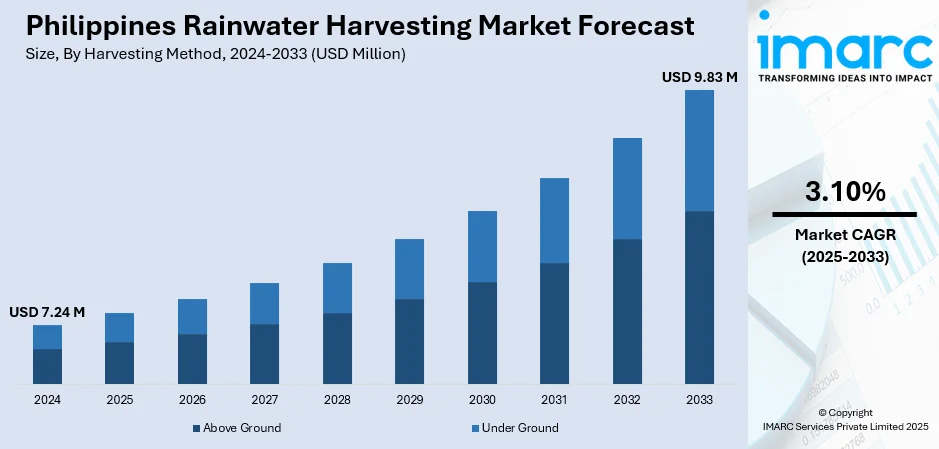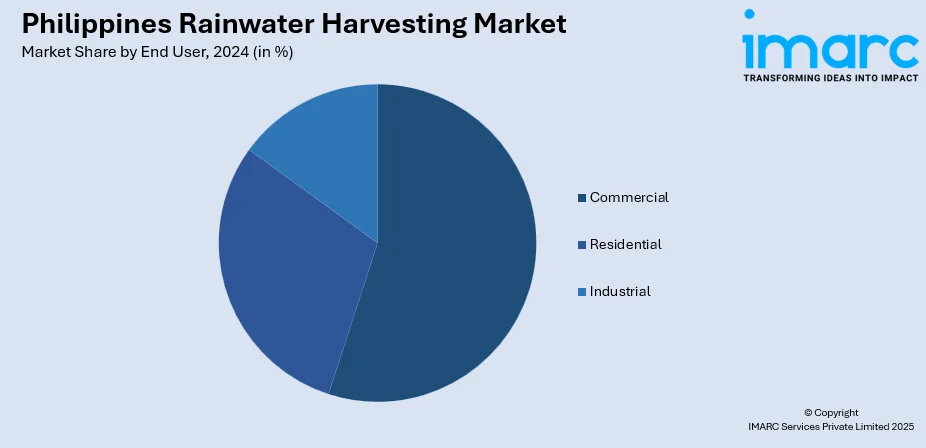
Philippines Rainwater Harvesting Market Size, Share, Trends and Forecast by Harvesting Method, End User, and Region, 2025-2033
Philippines Rainwater Harvesting Market Overview:
The Philippines rainwater harvesting market size reached USD 7.24 Million in 2024. Looking forward, the market is projected to reach USD 9.83 Million by 2033, exhibiting a growth rate (CAGR) of 3.10% during 2025-2033. The market is witnessing steady growth as water scarcity, urbanization, and climate challenges drive adoption of sustainable water management solutions. Government initiatives promoting eco-friendly practices, along with rising awareness among households and industries, are also supporting system installations across rural and urban areas. Growing demand for cost-effective, environment-friendly alternatives to traditional water sources is further boosting uptake, strengthening the overall Philippines rainwater harvesting market share.
|
Report Attribute
|
Key Statistics
|
|---|---|
|
Base Year
|
2024
|
|
Forecast Years
|
2025-2033
|
|
Historical Years
|
2019-2024
|
| Market Size in 2024 | USD 7.24 Million |
| Market Forecast in 2033 | USD 9.83 Million |
| Market Growth Rate 2025-2033 | 3.10% |
Philippines Rainwater Harvesting Market Trends:
Government Incentives and Policy Support
The Philippine government is actively encouraging sustainable water management practices by offering incentives, subsidies, and implementing local regulations that promote the adoption of rainwater harvesting. Municipalities are increasingly incorporating rainwater systems within urban planning frameworks to tackle the issues of growing water scarcity and flooding. Policies that require or suggest rainwater collection in new residential, commercial, and institutional developments are fostering a supportive environment for these systems. Furthermore, awareness campaigns and training initiatives are educating communities about the long-term advantages of water conservation. For instance, in April 2024, Residents in Patnanungan, Quezon, established water harvesting systems as part of DSWD's Project LAWA and BINHI, targeting food insecurity and water scarcity. Participants received training on disaster risk reduction and climate adaptation, alongside daily wage support for beneficiaries. Such initiatives support climate resilience and reduce reliance on conventional water supplies, making rainwater harvesting an economically viable solution. These efforts are contributing significantly to Philippines rainwater harvesting market growth, as both public and private sectors align with sustainability goals and environmental conservation targets, driving broader adoption across diverse end-user segments.

To get more information on this market, Request Sample
Adoption in Rural and Agricultural Areas
Rainwater harvesting is increasingly vital in rural regions of the Philippines, providing reliable access to water for irrigation and household needs. Farmers are implementing these systems to tackle irregular rainfall and the high costs associated with conventional water supply. By capturing and storing rainwater, agricultural communities can maintain crop productivity during dry spells, reduce dependence on groundwater, and mitigate the risks of water shortages. In July 2023, the Department of Agriculture implemented water management strategies to combat the effects of El Niño on agriculture, promoting rainwater harvesting and improving irrigation systems. The agency works with various departments to enhance food production and security. This approach improves food security and supports sustainable farming practices. The recognition of rainwater harvesting as a cost-effective and eco-friendly solution is facilitating broader adoption across rural landscapes, strengthening agricultural resilience in the Philippines.
Philippines Rainwater Harvesting Market Segmentation:
IMARC Group provides an analysis of the key trends in each segment of the market, along with forecasts at the country and regional levels for 2025-2033. Our report has categorized the market based on harvesting method and end user.
Harvesting Method Insights:
- Above Ground
- Under Ground
The report has provided a detailed breakup and analysis of the market based on the harvesting method. This includes above ground and under ground.
End User Insights:

- Commercial
- Residential
- Industrial
A detailed breakup and analysis of the market based on the end user have also been provided in the report. This includes commercial, residential, and industrial.
Regional Insights:
- Luzon
- Visayas
- Mindanao
The report has also provided a comprehensive analysis of all the major regional markets, which include Luzon, Visayas, and Mindanao.
Competitive Landscape:
The market research report has also provided a comprehensive analysis of the competitive landscape. Competitive analysis such as market structure, key player positioning, top winning strategies, competitive dashboard, and company evaluation quadrant has been covered in the report. Also, detailed profiles of all major companies have been provided.
Philippines Rainwater Harvesting Market News:
- In March 2024, the MMDA created designs for rainwater catchment systems to help Metro Manila LGUs address water shortages due to El Niño. The initiative includes installing systems in parks and raising awareness about rainwater reuse. Despite declining water levels, officials report no imminent rationing for March.
- In February 2024, Surigao del Norte Rep. Robert Ace Barbers advocated for House Bill No. 4837, which mandates the installation of rainwater collection systems in new residential and commercial buildings. The bill aims to ensure water supply during El Niño and reduce flooding in urban areas, offering tax incentives for compliance.
Philippines Rainwater Harvesting Market Report Coverage:
| Report Features | Details |
|---|---|
| Base Year of the Analysis | 2024 |
| Historical Period | 2019-2024 |
| Forecast Period | 2025-2033 |
| Units | Million USD |
| Scope of the Report |
Exploration of Historical Trends and Market Outlook, Industry Catalysts and Challenges, Segment-Wise Historical and Future Market Assessment:
|
| Harvesting Methods Covered | Above Ground, Under Ground |
| End Users Covered | Commercial, Residential, Industrial |
| Regions Covered | Luzon, Visayas, Mindanao |
| Customization Scope | 10% Free Customization |
| Post-Sale Analyst Support | 10-12 Weeks |
| Delivery Format | PDF and Excel through Email (We can also provide the editable version of the report in PPT/Word format on special request) |
Key Questions Answered in This Report:
- How has the Philippines rainwater harvesting market performed so far and how will it perform in the coming years?
- What is the breakup of the Philippines rainwater harvesting market on the basis of harvesting methods?
- What is the breakup of the Philippines rainwater harvesting market on the basis of end user?
- What is the breakup of the Philippines rainwater harvesting market on the basis of region?
- What are the various stages in the value chain of the Philippines rainwater harvesting market?
- What are the key driving factors and challenges in the Philippines rainwater harvesting market?
- What is the structure of the Philippines rainwater harvesting market and who are the key players?
- What is the degree of competition in the Philippines rainwater harvesting market?
Key Benefits for Stakeholders:
- IMARC’s industry report offers a comprehensive quantitative analysis of various market segments, historical and current market trends, market forecasts, and dynamics of the Philippines rainwater harvesting market from 2019-2033.
- The research report provides the latest information on the market drivers, challenges, and opportunities in the Philippines rainwater harvesting market.
- Porter's five forces analysis assist stakeholders in assessing the impact of new entrants, competitive rivalry, supplier power, buyer power, and the threat of substitution. It helps stakeholders to analyze the level of competition within the Philippines rainwater harvesting industry and its attractiveness.
- Competitive landscape allows stakeholders to understand their competitive environment and provides an insight into the current positions of key players in the market.
Need more help?
- Speak to our experienced analysts for insights on the current market scenarios.
- Include additional segments and countries to customize the report as per your requirement.
- Gain an unparalleled competitive advantage in your domain by understanding how to utilize the report and positively impacting your operations and revenue.
- For further assistance, please connect with our analysts.
 Request Customization
Request Customization
 Speak to an Analyst
Speak to an Analyst
 Request Brochure
Request Brochure
 Inquire Before Buying
Inquire Before Buying




.webp)




.webp)












